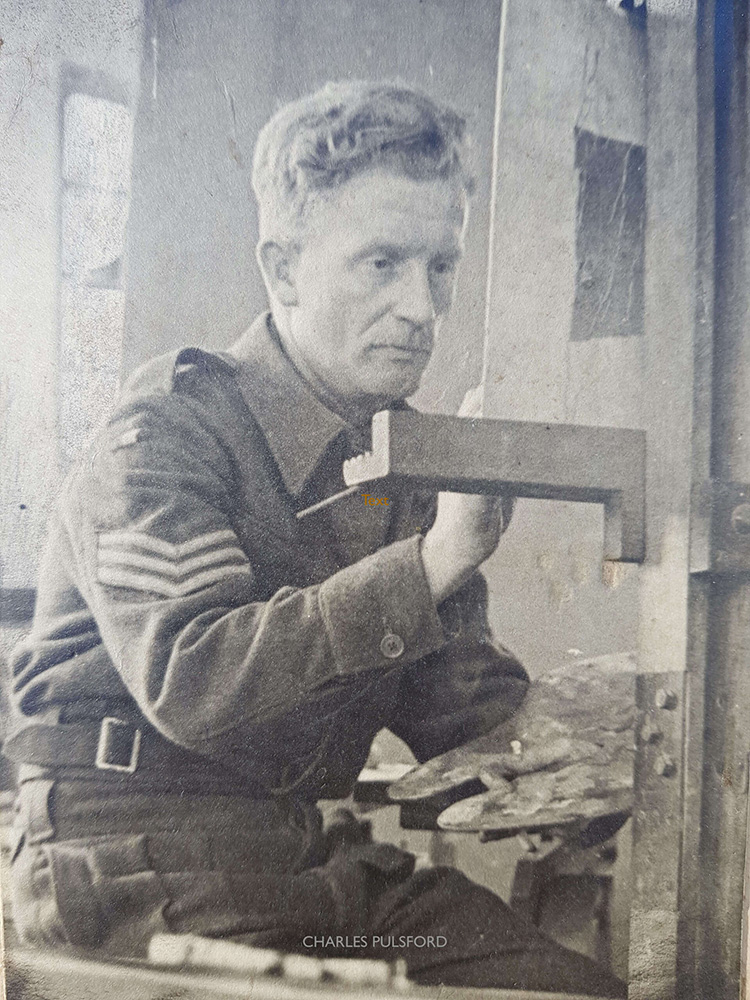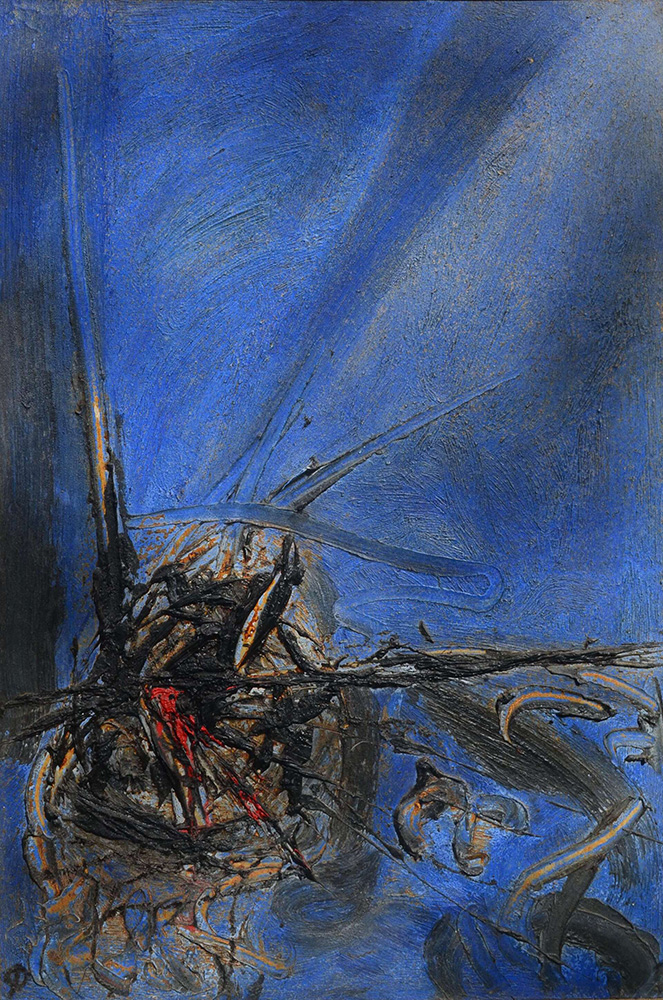CHARLES PULSFORD
PAINTER AMONG POETS
Three in a row, and each one mad,
looking with innocence upon
the smiling cruel, the gaily sad.
Their witless eyes beam down
on struggling song and word and stone.
Each bears a blinding crown.
Opening lines from the unpublished poem Three Angels By Norman MacCaig April 1952
The paintings across the top of the page are both part of the Scottish National Gallery of Modern Art (Edinburgh) holding of work by Charles Pulsford.
To the left, made at the Hospitalfield postgraduate school in 1939, is the earliest surviving painting by CP, here referred to as Figure with Attendants; to the right, Three Angels, the inspiration for the poem quoted above.
Charles always found the company of poets compatible, his own talent and significance more readily accepted among the literary figures of post-war Edinburgh: MacCaig, Chris Grieve (Hugh MacDiarmid), Sydney Goodsir Smith, Sorley MacLean and others embraced him as one of their own, while in the visual arts world (whose tenets he challenged) he remained too problematic to be fully accepted.
As the text below relates, however, he was far from being in any sense an ‘outsider-artist’ in his origins, his connections or in his eventual influence as an educationist.
CHARLES PULSFORD ARSA
Charles Pulsford was a Scottish artist who was active from the 1930s until the 1970s. His experience at the Edinburgh College of Art of the ’thirties was to be rigorously schooled in technique, while identifying with artistic adventurousness and excitement from continental Europe.
He and his friend and fellow Fifer William Gear went to Paris together in the autumn of 1938, where they met up with Glaswegians Robert Colquhoun and Robert MacBryde: a fine quartet of Scottish portent, all of them soaking up the creative milieu of the Boul Mich. There they met, among others, Fernand Léger and Alberto Giacometti.
After the war, once again in Edinburgh, Charles set about the task of finding his own distinct artistic identity.
He acknowledged that his ‘breakthrough’ image, marking his self-discovery as an artist, was Three Angels (1949) – see above right. Most of CP’s mature work is characterised by expert use of the palette-knife, of which he became a master. Semi-abstract figures, often with pagan names and accoutrements, dominated his work in the early ’fifties (his Edinburgh years). King and Queen (1950), Angel (1950) and Demeter (1952) are examples from this phase.
In the middle and later years of that decade, still in Scotland but living in East Lothian, his imagery morphed to focus on groups of figures, now unnamed, no less mysterious.
The two paintings entitled Figures in a Landscape (1956 & 1957) are examples shown here. After his move to England in 1960 and until 1968, his work became more fluid, organic, and more fully abstract. Hephaestus (1962) is the earliest of five such works shown here; Great Demeter (1967-68) which measures 2.44m x 1.53m of thick sand-and-oil impasto is the last in the unbroken sequence of ‘pure’ paintings Charles Pulsford ever made.
Additional Biographical Details
By an accident of location, Charles Pulsford was born to Scottish parents in Staffordshire, England, not in Scotland, on 8th June 1912. His father, in the Mercantile Marine, was killed in the early months of the ’14 – ’18 war and his mother returned to Scotland with her two (English-born) children, Charles and his brother Louis, and settled in Aberdour, a village across the Firth of Forth from Edinburgh. Charles always identified as Scottish.
He attended Aberdour Primary School and Dunfermline High School, leaving at the age of 16 for an apprenticeship at Ward’s Shipbreakers of Inverkeithing in Fife. He also worked as a wheel-tapper, testing for metal fatigue in railway rolling stock. Five years later (in 1933) he was awarded a Grant Scholarship to attend Edinburgh College of Art, where he achieved great distinction, being awarded a teaching fellowship (the first of its kind) in 1939. During the ’39 – ’45 war he served in the army in North Africa and Iraq, having volunteered in 1940.
Charles married Bronwen Gordon in July 1949.
He continued his lectureship in painting at Edinburgh College of Art from 1946 until 1960, in a full-time capacity from 1952. He had senior roles at Loughborough College of Art (1960-65) and Wolverhampton Polytechnic (1965-72). From 1965 until his retirement in 1972 he was the Fine Art representative on the National Validation Body for Tertiary Education in England & Wales, a precursor to the QAA. His tenure during the period of transition between the old NDD (National Diploma in Design) and its replacement, the degree-equivalent DipAD (Diploma of Art & Design) meant that his influence on Art & Design education was a lasting one.
He exhibited at Aitken Dott (now The Scottish Gallery) in Edinburgh and at Gimpel Fils in London among other galleries. He was elected as an associate of the Royal Scottish Academy in 1959. After his retirement he lived in Cambridge and in Suffolk with his wife, the stained glass designer Bronwen Gordon. He died in Bury St Edmonds, Suffolk, on 1st March 1989. Their daughter, Anna Wright, a jewellery designer, died in 2006. Their sons, Mark and Benedict, both painters, continue to uphold the family traditions.
The final phase of his work as an artist (1971-79) involved photography, collage, tantric colour circles and multi-media 3D design.
The paintings at the top of the page are part of the national collection of art. All but one of the rest (the red-and-blue Figures, owned by the late Katriona Savage’s estate) are in the possession of the Pulsford family or (in one case) has been bequeathed to them. During Charles Pulsford’s lifetime, significant quantities of his work passed into private ownership, and news of the whereabouts of uncatalogued works is welcome.
All messages and information about drawings, lithographs and paintings by CP may be sent to markpulsford@btinternet.com A fuller biographical treatment of this artist together with an expanding catalogue raisonné are available on request.


